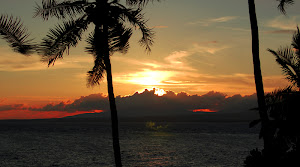The Badjao, often only known to tourists as street beggars, have much more to their substance and history than that. Honestly I was one who thought the Badjao were only the dark skinned beggars seen on the streets of Dumaguete, probably the disdain for them stems from prejudice and misunderstanding, still, we should understand that there is more to their story, even as we dislike what they have been reduced to in modern times. The historical Badjao are actually nomadic seafaring fishermen who with their whole families in tow, trying to eke out a living by fishing. They have plied the Sulu Sea and surrounding waters for centuries. Originally living on their boats some are born at sea even today. But this is a vanishing lifestyle.
Their centuries-old way of life is threatened by rising costs and shrinking fisheries. For some of the fishermen, their only hope is that their children won't have to follow in their footsteps. The motley caravan of boats, their engines popping in staccato rhythm, head out to sea sounding like a platoon of sputtering lawn mowers. Painted bright red, turquoise and orange, they carry a dozen men wearing baseball caps and T-shirts fashioned as turbans to block the equatorial sun.
Proud and hardworking, they're threatened by soaring costs for fuel and repairs, killer typhoons, pirates, religious rebels and the steady decline of fish poulations. Most Badjao here no longer live on their boats, instead taking up residence in thatch-roofed houses on bamboo stilts. But it seems they can't bear to be away from the water. Their communities extend 100 yards from the beach into the marshy coastal waters, connected by warrens of over-water pathways made of bamboo, wooden planks and overturned canoes.
They still go to sea in bancas, rickety craft with bamboo outrigging lashed together with wire and fishing line. They fashion their own hooks and lures. Small gas-powered motors and cellphones are their only modern conveniences. On the water, times are tough. On land, they are worse. Throughout the Philippines, more than 200,000 Badjao remain marginalized, shunned as uneducated and incorrigible. Non-Badjao children throw coins into the water and laugh as the fishermen scramble from their boats to compete for the handouts. Badjao who abandoned life at sea have ended up as street beggars in big cities such as Manila.
When times are good, they travel four hours out to sea where the stone fish, grouper, whitefish and tuna are bigger and more plentiful. A good catch brings only $20 for the entire group. When times are lean, they secure their gas on credit and take their chances closer to shore. Often they spend two days at sea and return with just two fish, barely enough to feed one person. For years, the Badjao have been known as masters of the seasonal currents of the Sulu and South China seas. Tradition has it that a Badjao fisherman, simply by dipping his hand in the water, can judge a current's direction and strength and the time it will take to reach his destination.
Some belive that the traditional Badjao lifestyle will survive into the 21rst Century, others fear they are doomed to becoming engulphed by a Philippines reluctant to address their needs as an independant and noble people.
Tuesday, August 4, 2009
Philippines' Badjao Sea Gypsies
Labels:
Philippine culture,
Philippine life
Subscribe to:
Comments (Atom)



